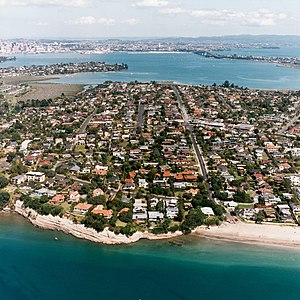Hauraki is a suburb in the southern North Shore of Auckland, the largest metropolitan city in New Zealand. It is under the local governance of the Auckland Council.
Hauraki | |
|---|---|
 Hauraki in 1992 | |
 | |
| Coordinates: 36°47′46″S 174°46′40″E / 36.79611°S 174.77778°E | |
| Country | New Zealand |
| City | Auckland |
| Local authority | Auckland Council |
| Electoral ward | North Shore ward |
| Local board | Devonport-Takapuna Local Board |
| Area | |
| • Land | 109 ha (269 acres) |
| Population (June 2024)[2] | |
• Total | 4,340 |
| Takapuna | (Rangitoto Channel) | (Rangitoto Channel) |
| (Shoal Bay) |
|
(Rangitoto Channel) |
| (Shoal Bay) | Bayswater | Belmont |
History
editThe traditional name for the western coastline in Hauraki was Waipaoraora, referring to the shell banks on the tidal flats of Shoal Bay.[3]
Demographics
editHauraki covers 1.09 km2 (0.42 sq mi)[1] and had an estimated population of 4,340 as of June 2024,[2] with a population density of 3,982 people per km2.
| Year | Pop. | ±% p.a. |
|---|---|---|
| 2006 | 3,792 | — |
| 2013 | 3,969 | +0.65% |
| 2018 | 4,131 | +0.80% |
| Source: [4] | ||
Hauraki had a population of 4,131 at the 2018 New Zealand census, an increase of 162 people (4.1%) since the 2013 census, and an increase of 339 people (8.9%) since the 2006 census. There were 1,434 households, comprising 1,998 males and 2,133 females, giving a sex ratio of 0.94 males per female. The median age was 37.0 years (compared with 37.4 years nationally), with 861 people (20.8%) aged under 15 years, 774 (18.7%) aged 15 to 29, 1,977 (47.9%) aged 30 to 64, and 522 (12.6%) aged 65 or older.
Ethnicities were 73.3% European/Pākehā, 6.0% Māori, 2.4% Pacific peoples, 22.6% Asian, and 3.3% other ethnicities. People may identify with more than one ethnicity.
The percentage of people born overseas was 40.4, compared with 27.1% nationally.
Although some people chose not to answer the census's question about religious affiliation, 56.9% had no religion, 32.6% were Christian, 0.3% had Māori religious beliefs, 1.2% were Hindu, 1.2% were Muslim, 1.4% were Buddhist and 1.5% had other religions.
Of those at least 15 years old, 1,329 (40.6%) people had a bachelor's or higher degree, and 207 (6.3%) people had no formal qualifications. The median income was $44,800, compared with $31,800 nationally. 1,008 people (30.8%) earned over $70,000 compared to 17.2% nationally. The employment status of those at least 15 was that 1,773 (54.2%) people were employed full-time, 459 (14.0%) were part-time, and 96 (2.9%) were unemployed.[4]
Education
editHauraki Primary School is a coeducational contributing primary (years 1–6) school with a roll of 484 as of August 2024.[5][6] Hauraki Primary School was founded in May 1954.[7] The majority of year sixes transfer to Belmont Intermediate School or Takapuna Normal Intermediate School. Clarinda Franklin has been the principal since 2000.
The Wilson School caters to students aged 5-21 with special needs. It’s part of the Wilson Trust and Te Whatu Ora's Wilson Centre. The school customizes the New Zealand Curriculum to suit individual learning requirements, emphasizing literacy, numeracy, and communication. It also nurtures social and physical skills, promoting independence. Wilson School prioritizes family engagement and maintains open communication with parents to enhance student learning outcomes.[citation needed]
Notes
edit- ^ a b "ArcGIS Web Application". statsnz.maps.arcgis.com. Retrieved 17 November 2023.
- ^ a b "Aotearoa Data Explorer". Statistics New Zealand. Retrieved 26 October 2024.
- ^ Cameron, Ewen; Hayward, Bruce; Murdoch, Graeme (2008). A Field Guide to Auckland: Exploring the Region's Natural and Historical Heritage (rev. ed.). Random House New Zealand. p. 148. ISBN 978-1-86962-1513.
- ^ a b "Statistical area 1 dataset for 2018 Census". Statistics New Zealand. March 2020. Hauraki (128800). 2018 Census place summary: Hauraki
- ^ "New Zealand Schools Directory". New Zealand Ministry of Education. Retrieved 17 September 2024.
- ^ Education Counts: Hauraki School
- ^ "Welcome". Hauraki School. Retrieved 28 May 2024.